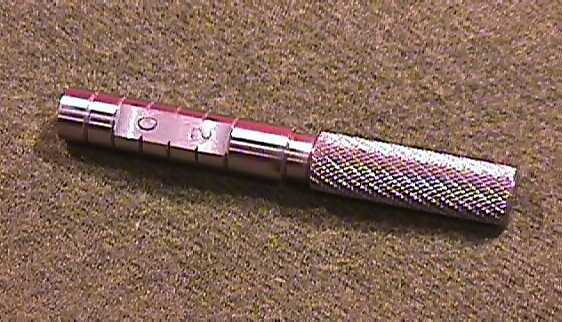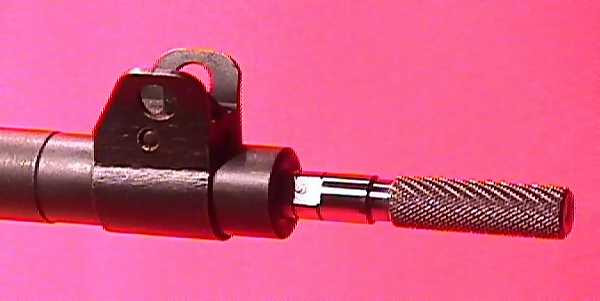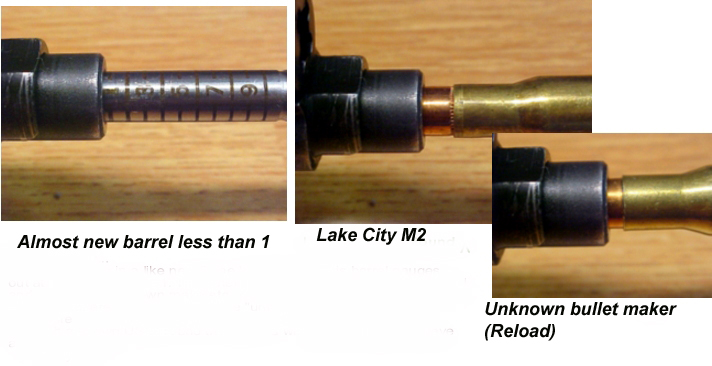-
FREE MEMBER
NO Posting or PM's Allowed

Using the M2 30.06 to measure muzzle wear question
Hello all,
so it is well known that we can use a 30.06 M2 ball to check muzzle wear but I'm not sure how that works. I read somewhere that the carbine ball is too short to be used for this purpose but since the 30.06 is also a .30 caliber bullet, shouldn't it fall into the muzzle all the way to the bullet shoulder? I guess what I dont understand is the physics behind what happens to the bullet as it is fired into the barrel. Are .30 caliber bullets slightly larger than the bore before fired and once they are fired they deform (elongate) in the barrel?
thanks
Information
 |
Warning: This is a relatively older thread
This discussion is older than 360 days. Some information contained in it may no longer be current. |
|
-
01-29-2011 02:12 PM
# ADS
Friends and Sponsors

-
Legacy Member

Bore, 30 caliber, 0.308 inches
Lands, 30 caliber, 0.302 inches
You are using curved surface up to 0.308 to measure 0.302 or more if the bore is used. How far the curved surface goes into the muzzle can tell you about how much the barrel has been used. A rough test that gives you, Good, Maybe ok, or Not good, run. The more experienced you are using the same bullet the better you can get at guaging the muzzle wear. It helps to have a like new 30 caliber muzzle to test the bullet on first. That will tell you where like new 0.302 falls on your test bullet.
-
-
-
Or you can go the expensive way and buy a gauge. But it is $30-$35. A lot if you don't use it a bunch. But easier to carry and use at a gun show the a live round.

 [COLOR="Silver"]
[COLOR="Silver"]
-
Thank You to JimF4M1s (Deceased) For This Useful Post:
-
FREE MEMBER
NO Posting or PM's Allowed

Ah I see. So the diameter of the bullet itself is .308 inches and as the bullet is going down the barrel is it essentially being grooved and squeezed by the lands since the lands are .302 inches?
-
Welcome to the forum trekvana
Jim and Bubba7 are correct. A gauge is a good investment, but if you're in a pinch an M2 round may prevent you from buying a rifle with a worn out barrel.
Jim also made a good point about gun shows -
Many gun shows frown on carrying live ammo for obvious safety reasons. You may even be bounced right out at some shows.
The bullet test is only used as a rough guide, but it works ok as a quick tool such as if you come across a nice looking rifle but want to know how worn the bore is. If the muzzle swallows the bullet down to the shell casing you know the bore is probably worn out.
You’re only using the taper of the bullet as a relative guide as to how far it goes into the muzzle, and it’s not exact. Also the taper of bullets from different manufacturers may vary.
You asked why an M1 carbine round wouldn't work -
carbine round wouldn't work -
The bullet tip for an M1 carbine is short and round, so it doesn’t work very well because the relative differences in muzzle size is hard to see. (Even on a new barrel, the muzzle is very close to the front of the shell casing)
The taper of an M2 bullet is long, so you can see the small differences of how far it will go into the muzzle better.
The photos below might help to better understand. These are measurements using the same M1 Garand with an almost new barrel.
(It works the same for an M1 carbine)

-
The Following 5 Members Say Thank You to Harlan (Deceased) For This Useful Post:
-
FREE MEMBER
NO Posting or PM's Allowed

thanks guys. that was very informative
-trek
-
Legacy Member

Not yet; the reason you use the M2 Ball rather than the Carbine Ball is because with the .30 Carbine, the ogive (round nose bullet shape) goes almost all the way back to the shell casing. On the .30-'06 M2 Ball, a substantial amount of straight bullet body behind the ogive of the bullet nose is exposed before the shell casing. Some very tight Carbine muzzles will show a little copper using a .30 Carbine, but you can't put a number to it without using the M2 Ball or a gauge. Most Carbines will swallow the whole bullet of a .30 Carbine round, but they still could have a decent muzzle. My Inland shows 1/16" of bullet with the .30 Carbine.
-
-
Advisory Panel


Somewhere in this whole mess is the formula for how much bullet shows compared to the gauge indicating a 1 or 1.5 or 2...Anyone remember where to find it?
-
-
FREE MEMBER
NO Posting or PM's Allowed

Although it's pretty self evident I wondered if there is a proper way to read a .30 M1 Garand-type muzzle gauge? I have one just like the one pictured in post #3 above.
Garand-type muzzle gauge? I have one just like the one pictured in post #3 above.
When using one of these gauges is it normal to get different readings depending on how the gauge is turned when inserted into a barrel? (Due to the flat cutout area not coming in contact with the rifling) or should the gauge read the same no matter how it is facing in the barrel?
I tried my gauge on two different Garand's from two different sources and when inserting the gauge with the “flat” part facing at the 12 or 6 o'clock position I get a reading of about 1.25 but when I remove and reinsert the gauge in the 3 or 9 o'clock position I get a reading of about 1.75.
Are varying muzzle readings like this the norm? If so, using my example from above, would my barrel rate 1.25 or 1.75?
I don't have a muzzle of less than -1 to try the gauge (which is below the flat cutout) to see if it reads the same in any position.
Thanks.
-
Legacy Member

A guage with a cut out, you have to rotate it to get the less MW. The lands are not wore equally so you have to be sure you read on the tallest one. If the tallest one is in the cut out, you will get a larger reading. Guages without a cut out are easier.
-















 Register To Reply
Register To Reply









 [COLOR="Silver"]
[COLOR="Silver"]





